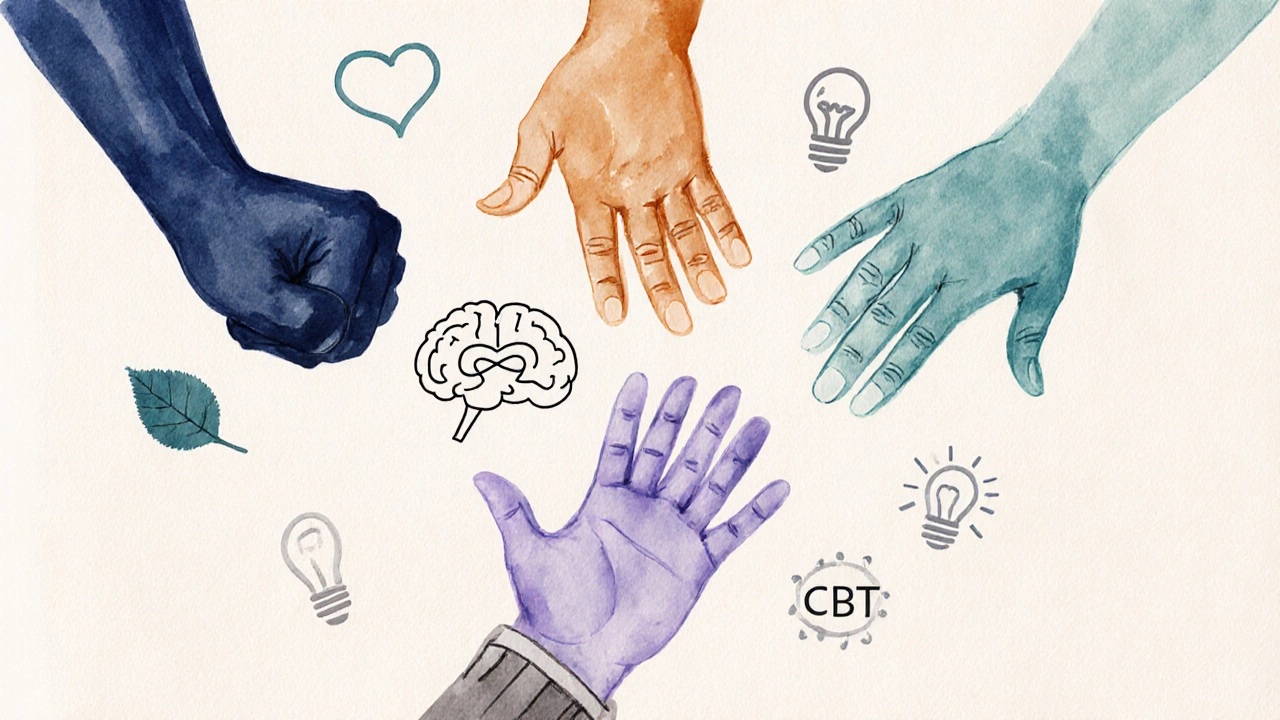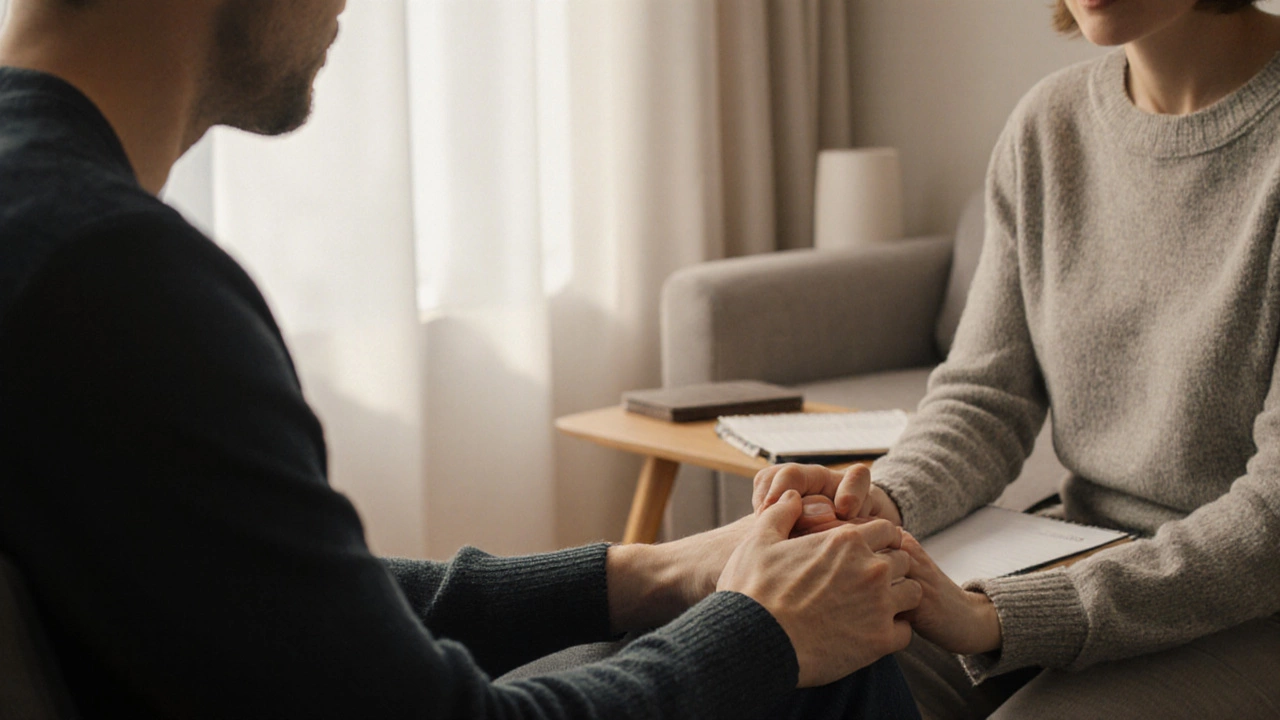Therapist Hand Observation Guide
What Therapists Look For
Therapists observe hand movements to gather non-verbal data that complements what you say. These cues provide insights into your emotional state, stress levels, and readiness to engage in therapy.
Select a hand cue and click "Analyze Hand Cue" to see what therapists observe and how it relates to your therapy experience.
Therapy Models That Use Hand Observation
Somatic Therapy
Focuses on physical sensations and body-based healing. Hand tension may indicate stored emotional trauma.
Psychodynamic
Examines unconscious patterns. Withdrawing hands may signal fear of vulnerability.
CBT
Even thought-focused therapies use hand cues to detect emotional charge in thoughts.
Ever felt your therapist’s eyes linger on your hands during a session and wondered what’s up? It’s not a weird habit - it’s a deliberate tool. By watching hand movements, therapists tap into a silent language that often says more than words. Below are the key reasons behind this practice and how it can actually help you get more out of therapy.
Quick takeaways:
- Hand gestures reveal emotion, stress, and hidden thoughts.
- Therapists use them to assess anxiety, trauma, and readiness to change.
- Observing hands fits into several therapeutic models, especially somatic and psychodynamic approaches.
- Understanding the purpose can reduce the awkward feeling and improve the therapeutic alliance.
- Clients can use simple tips to make hand‑focused observations work for them.
What the therapist is actually looking at
When a therapist watches your hands, they are decoding hand gestures small, often unconscious movements of the fingers, palms, or wrists that reflect internal states. A clenched fist might signal anger or fear, while a relaxed open palm can indicate openness and safety. Even subtle tremors can hint at anxiety spikes.
These cues are part of a broader body language the non‑verbal signals we send through posture, facial expression, and movement that our brain processes faster than spoken words. By focusing on hands, therapists get a clearer window into the subconscious because hands are less under voluntary control than facial muscles.
Why hand observation matters in a clinical assessment the structured process of gathering information to understand a client’s mental health
During the first few sessions, therapists build a mental map of your emotional baseline. Hand movements serve as real‑time data points for:
- Detecting anxiety. Rapid finger tapping or shaking often spikes when a client feels nervous.
- Spotting trauma triggers. A sudden tightening of the grip can signal that a memory is resurfacing.
- Measuring engagement. Open, expressive hand use usually means the client feels safe to explore deeper topics.
These observations help the therapist tailor interventions on the fly, rather than waiting for the client to verbalize every feeling.
How hand‑focused observation fits into different therapy models
Somatic therapy a body‑oriented approach that works with physical sensations to process emotions explicitly uses the body as a diagnostic tool. Practitioners believe that unresolved emotional material is stored in muscular tension, often visible in the hands. By noticing a client's clenched fingers, a somatic therapist can guide a grounding exercise to release that tension.
In psychotherapy talk‑based treatment for mental health issues, especially psychodynamic and relational styles, the therapist watches hands to gauge the unconscious relational patterns. A client who consistently hides their hands may be indicating a fear of being vulnerable.
Even in cognitive‑behavioral therapy (CBT), which is mostly thought‑focused, hand gestures can signal when a thought is emotionally charged. A therapist might pause and ask, “I notice you’re gripping the armrest - what’s happening right now?” This bridges the gap between thought and feeling.
What you can learn from a therapist’s focus on hands
Understanding why a therapist watches your hands transforms a potentially awkward moment into a learning opportunity. You’ll start to notice patterns you might have missed:
- Stress signals. If you’re constantly fidgeting, you might benefit from relaxation techniques.
- Emotional blocks. A sudden tightening when a topic comes up can point to a hidden belief worth exploring.
- Progress markers. Over time, you may see your hand movements become more relaxed, indicating increased comfort.
These insights empower you to become an active participant in the therapeutic process rather than a passive recipient.
Practical tips: Using hand observation to enhance your sessions
Here are simple steps you can take if you want to make the most of this non‑verbal feedback loop:
- Notice your own hands. Before a session, take a minute to observe your posture and hand position. Are they tense?
- Ask for clarification. If you feel the therapist is “reading” you, say, “I see you’re watching my hands - what do you notice?” This builds a collaborative vibe.
- Practice grounding. If you feel your hands tightening, try a quick grounding exercise: press your palms together and breathe for three counts.
- Use gestures deliberately. When you feel safe, open your hands and gesture while speaking. It can reinforce confidence and signal openness.
Remember, the goal isn’t to perform; it’s to let the therapist see honest, unfiltered signals that help them guide you more effectively.

Common misconceptions about hand‑focused observation
Many people think a therapist watching their hands is “creepy” or a sign of judgment. In reality, it’s a neutral, evidence‑based technique. The therapist isn’t trying to read your mind; they’re gathering physiological data that complements what you say.
Another myth is that if you’re “good at hiding” your hands, the therapist can’t help you. That’s false. Even the tiniest micro‑movements, like a slight flick of a finger, trigger the brain’s mirror‑neuron system, giving the therapist subtle clues about affect.
Comparison: Hand cues vs. facial cues
| Aspect | Hand cues | Facial cues |
|---|---|---|
| Voluntary control | Low - often unconscious | Higher - can be masked |
| Signal type | Stress, tension, openness | Emotion, attention |
| Therapeutic use | Grounding, somatic work | Empathy, mirroring |
| Typical observation | Clenches, fidgeting, gestures | Micro‑expressions, eye contact |
When hand observation signals deeper issues
Sometimes, persistent hand tension can indicate chronic anxiety a state of excessive worry that persists over time or unresolved trauma the emotional imprint left by a distressing event. If a therapist repeatedly notes hand clenching across sessions, they may explore coping mechanisms, breathing exercises, or refer you for trauma‑focused work.
In some cases, hand observation reveals a breakdown in the therapeutic alliance the collaborative and trusting relationship between therapist and client. When a client’s hands are withdrawn, the therapist might address the alliance directly: “I notice you’re keeping your hands in your lap; does that feel safe for you?” This openness can repair the alliance.
Key takeaways for clients
- Therapists watch hands to gather honest, non‑verbal data.
- Hand cues complement words, helping tailor interventions.
- Recognizing your own hand signals can boost self‑awareness.
- Open communication about what you notice strengthens the therapeutic relationship.
- Persistent tension may signal anxiety or trauma that warrants deeper work.
Frequently Asked Questions
Why do therapists focus more on my hands than my face?
Hands are less under conscious control than facial expressions, so they often reveal genuine feelings that a client might mask with a smile. Therapists use both cues, but hand movements give a reliable baseline for stress and openness.
Is it okay to tell my therapist I feel uncomfortable with their hand observations?
Absolutely. A good therapist welcomes feedback. Discussing how the observation makes you feel can actually deepen the therapeutic alliance and improve the effectiveness of sessions.
Can I practice hand‑relaxation techniques on my own?
Yes. Simple exercises like clenching and releasing fists, or pressing palms together while breathing, can reduce tension. Incorporating these before a session can help you feel more present.
Do all therapy modalities use hand observation?
Most do, but the emphasis varies. Somatic and psychodynamic approaches rely heavily on it, while purely cognitive models may glance at it only to gauge anxiety spikes.
What if my hands never move? Does that mean I’m fine?
A lack of movement can also signal disengagement or a fear of being seen. Therapists may explore why you feel the need to stay still and work on building safety.

 Surviving Open Heart Surgery: How Rare Is Survival and What Are the Real Odds?
Surviving Open Heart Surgery: How Rare Is Survival and What Are the Real Odds?
 Why Waking Up at 3 AM? Ayurveda Explains
Why Waking Up at 3 AM? Ayurveda Explains
 Common Mistakes to Avoid in Ayurvedic Medicine
Common Mistakes to Avoid in Ayurvedic Medicine
 Should I Force My Knee to Bend After Knee Replacement?
Should I Force My Knee to Bend After Knee Replacement?
 Biggest Health Concerns Facing Medical Tourists in Costa Rica
Biggest Health Concerns Facing Medical Tourists in Costa Rica